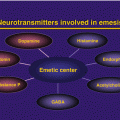© Springer International Publishing Switzerland 2015
Ramon Andrade de Mello, Álvaro Tavares and Giannis Mountzios (eds.)International Manual of Oncology Practice10.1007/978-3-319-21683-6_4141. Brain Metastases
(1)
Department of Medical Oncology, Federal University of São Paulo, UNIFESP, Rua Pedro de Toledo, 377, CEP 04039-031 São Paulo, SP, Brazil
(2)
Department Biomedical Sciences and Medicine, University of Algarve, Faro, Portugal
(3)
Department of Medicine, Faculty of Medicine, University of Porto, Porto, Portugal
41.1 Introduction
Metastasis to the brain is the most feared complication of systemic cancer, and it is the most common intracranial tumor in adults, occurring in 20–40 % of patients diagnosed with advanced cancer, which exceeds the frequency of primary tumors. The true incidence of brain metastases is unknown, but studies from the United States show an approximate incidence of 200,000 new cases annually. Recently, an increase in the incidence of brain metastasis (BM) was observed, which is probably due to an increased overall survival as a result of therapeutic advances and better radiologic examinations [1–4].
Any type of cancer can compromise the central nervous system (CNS), although in adults, lung cancer is the most associated with brain metastases (around 50 % of all cases), mainly oat-cell carcinoma. Other neoplasms commonly associated with BM are breast cancer , renal cell carcinoma, colorectal cancer, germ cell tumor, and melanoma [3]. This was demonstrated in a large study by the Metropolitan Detroit Cancer Surveillance System, which estimated the incidence of BMs from 1973 to 2001. The study found a cumulative incidence of BMs of 9.6 % for all primary sites combined, with the highest in the lungs (19.9 %), followed by melanoma (6.9 %), renal (6.5 %), breast (5.1 %), and colorectal (1.8 %) cancers [4].
BMs can be single or multiple, and they are often found in the gray/white matter junction; 80 % are found in the cerebral hemispheres, 15 % in the cerebellum, and 5 % in the brainstem. The mechanisms of metastases include hematogenous spreading or invasion by contiguity. Another possible mechanism is dissemination to the posterior fossa by the venous plexus of Batson, as in pelvic tumors [5, 6].
41.2 Clinical Manifestations
BMs are symptomatic in more than two-thirds of patients, with similar manifestations observed in primary brain tumors. Generally, the onset of symptoms is subacute, and BM has variable clinical features depending on the location, number of lesions, and associated complications (e.g., bleeding or hydrocephalus). In some cases, BMs can occur with intratumoral hemorrhage, and most are associated with melanoma and choriocarcinoma, which lead to an acute onset of symptoms.
The most common symptoms are due to an increase in the intracranial pressure (e.g., headache, nausea, and vomiting). Seizures, memory problems, mood or personality changes, and focal neurological dysfunction (e.g., ataxia, hemiparesis, and language disturbs) are other possible symptoms [7–10]. However, 10 % of patients may be asymptomatic, and the BM is discovered after cranial imaging as part of disease staging.
BMs can occur as the first manifestation of cancer (observed in 5–10 % of all patients), and they can present synchronously with systemic and intracranial cancer (5–10 %). However, it is more common for them to present metachronously after the diagnosis of systemic cancer (>80 % of all patients).
41.3 Diagnosis
Any patients with a cancer diagnosis who present with neurologic symptoms must be examined carefully, and imaging studies must be performed to exclude BMs. Usually the first examination is CT of the brain, because it is an easily accessibility and inexpensive diagnostic tool that shows lesions with circumscribed margins, associated vasogenic edema, and localization at the junction of the grey/white matter. However, there is a great deal of variability in the appearance of these tumors.
MRI with contrast enhancement is the preferred exam, because it has a better sensitivity and specificity than other imaging modalities for determining the presence, location, and number of metastases. The aspect is typically iso- to hypointense on T1- and hyperintense on T2-weighted images. Spectroscopy shows intratumoral choline peaks with no choline elevation in the peritumoral edema [11, 12].
Differential diagnosis includes primary brain neoplasm (especially glioblastoma), cerebral abscess, subacute stroke, and demyelinating diseases [9].
In patients with unknown primary cancer and BMs, a history and physical examination are the first steps, followed by imaging studies. The lung should be the primary focus of evaluation because of the high prevalence of BMs in this type of tumor. The use of blood markers (i.e., the carcinoembryonic antigen [CEA], alpha-fetoprotein, prostate-specific antigen [PSA], and Ca-125) and endoscopic exams should be realized upon suspicion. PET-CT may be used as part of the investigation, and biopsy should be reserved for cases with doubt or when the primary site is not identified [13, 14].
41.4 Prognostic Factors
The most used prognostic classification system was created by the Radiation Treatment Oncology Group, which uses recursive partitioning analysis (RPA). There are three prognostic classes with important differences in survival [15]. Class 1 patients (16–20 % of all patients) have the following: a Karnofsky Performance Status (KPS) >60, aged <65 years, and no evidence of extraneural metastases or controlled primary cancer. Class 3 patients (10–15 % of all patients) have a KPS <70 and class 2 patients (65 % of patients) include all patients that cannot be classified under class 1 or 3.
41.5 Treatment
In general, patients with BMs typically have a mean survival of 1 month without treatment. With treatment, survival improves, but it is still discouraging. The management of BMs is divided in two major goals: symptomatic control and specific cancer treatment [16].
41.5.1 Symptomatic Treatment
Symptomatic treatment includes the management of brain edema, hydrocephalus, prophylaxis of seizures, and possible complications. The first step consists of administering steroids and anticonvulsants. Steroids are used to minimize vasogenic edema, which leads to an improved clinical condition. The most used steroid is dexamethasone, an empiric dose of 4–16 mg daily, because it is the most potent, has the best CNS penetration, and the least mineralocorticoid side effects. As the clinical situation permits, the lowest dose of dexamethasone that controls the symptoms should be used in order to avoid adverse effects [7, 8, 16, 17]. Symptomatic treatment with steroids alone prolongs survival for approximately 2.5 months.
Seizures are one of the most commons symptoms in patients with BMs that occur in >25 % of all cases and the use of antiepileptic drugs (AEDs) is recommended after the first episode and for prophylaxis immediately following surgical resection. There are no rules regarding the use of AEDs as prophylaxis for seizures in patients without a previous history of seizures [18]. Among the classes of AEDs, non-enzyme-inducing AEDs such as pregabalin, lamotrigine or topiramate are preferred to avoid drug interactions with others drugs and chemotherapy [19].
BMs are associated with an increased risk for venous thrombosis due to a hypercoagulable state, with an estimated incidence of 20 % in this patient population. The main treatment is anticoagulation with a low molecular weight (LMW) heparin or warfarin. LMW is preferred because of its increased effectiveness in preventing recurrent thromboembolism, it has no interaction with other drugs, and it is convenient. In case of metastases associated with an increased risk of hemorrhage (e.g., melanoma, choriocarcinoma, thyroid carcinoma, and renal cell carcinoma) the use of an inferior vena cava filter is recommended [10, 20]. Prophylaxis with anticoagulant is not routinely indicated, and it should be reserved for the perioperative period [21].
41.5.2 Specific Treatment
Specific treatment can be realized in three main modalities, usually in combination with radiation, systemic therapy with chemotherapy, and surgical resection. The goals are to prolong survival and improve quality of life, and the approach is based on the characteristics of the tumor (i.e., the size, location, and number of metastases), KPS, patients’ age, and prognosis [7–10, 16




Stay updated, free articles. Join our Telegram channel

Full access? Get Clinical Tree





